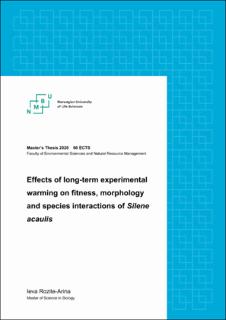| dc.description.abstract | The global annual average surface temperature has increased significantly during the past century and is predicted to continue rising. Studies have shown that alpine ecosystems can be particularly sensitive to climate change. However, due to the complexities of interactions between biotic and abiotic factors, a lot remains unknown regarding the magnitude of climate change impacts on alpine plant communities. Cushion plants are known to play a key role in alpine communities by creating micro-environments that are beneficial for other species. Silene acaulis is a long-lived cushion plant that is found in alpine and arctic habitats in the northern hemisphere. Several studies have explored the short-term effects of elevated temperatures on the fitness, performance and interactions of S. acaulis with other species, but less is known about the long-term effects of warming on S. acaulis despite its ecological importance. Thus, the objective of this thesis was to investigate how prolonged changes to climate will affect the fitness, morphology and species interactions of S. acaulis
The study was conducted at Finse, western Norway, in an ongoing long-term, open-top chamber (OTC) experiment. For all S. acaulis cushions found inside control plots and OTCs, I measured the size of the cushions, the number of fruits per cushion, morphological traits (colour, height and shape), and counted the number of individuals growing inside the cushions. In addition, air and soil temperature was measured during the summer of 2019 for a subset of control plots and OTCs.
Unusually low rates of reproduction were observed at the site with only eight out of 56 individuals containing fruits. Experimental warming was not a significant predictor for fruit production, but a correlation was found between the probability of fruits and cushion size, with larger cushion being more likely to contain fruits. Cushions inside warmed plots were found to have more discolouration, potentially due to heat damage caused by midday temperature spikes considerably above the species optimum. A shift in species interactions was found with a decline in the number of lichens and bryophytes per cushion inside warmed plots, while the number of vascular plants was not affected by warming. | en_US |

